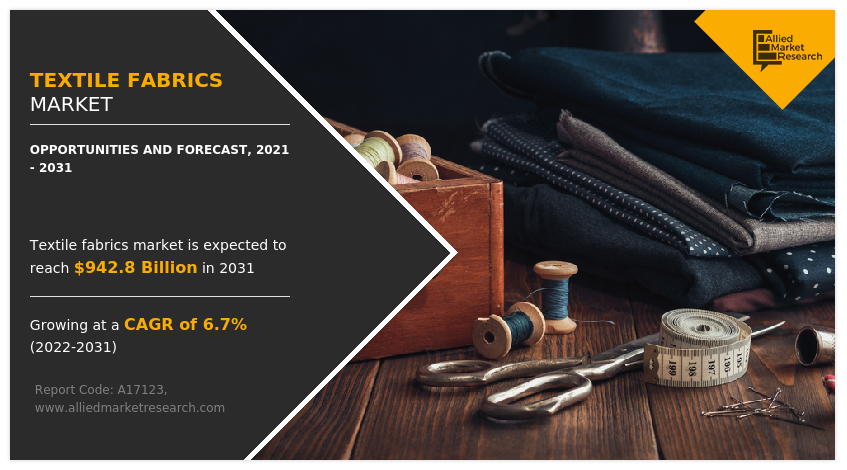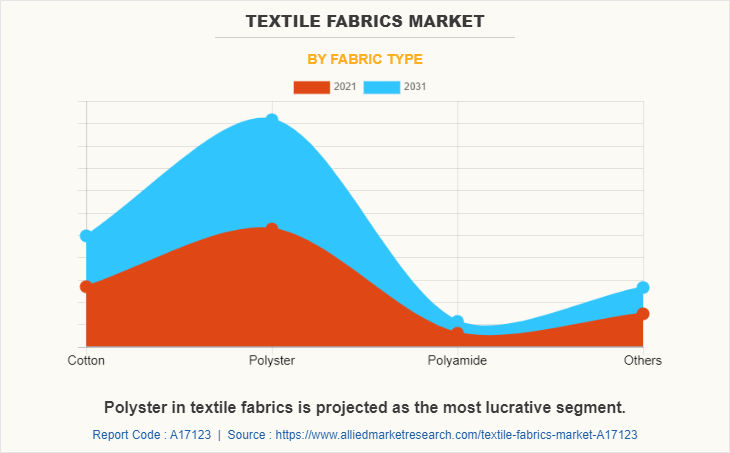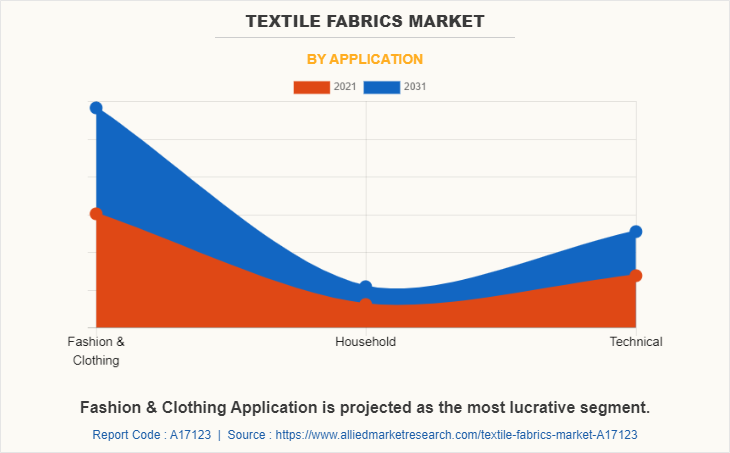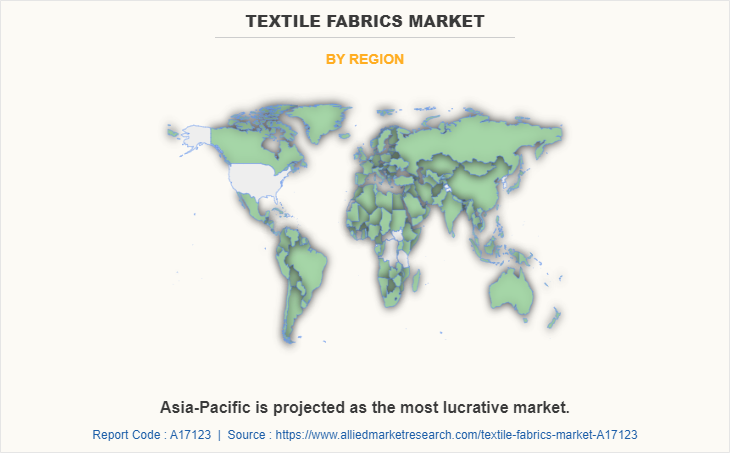Textile Fabrics Market Outlook - 2031
The global textile fabrics market size was valued at $498.0 billion in 2021, and is projected to reach $942.8 billion by 2031, growing at a CAGR of 6.7% from 2022 to 2031. The growth of the textile fabrics market is significantly driven by increasing consumer demand for sustainable products, with a focus on eco-friendly fabrics like biodegradable and recycled materials. In addition, the rising popularity of smart textiles, which incorporate technology for functionalities such as health monitoring and temperature regulation, is fueling innovation. These trends align with consumers' preferences for both sustainability and advanced, functional textile solutions, boosting market expansion.
Textile fabric is as two-dimensional plane-like structures made of textile materials, having reasonable strength, elongation, and flexibility, used for different applications including apparels, technical, sportswear ,and others. Textiles fabrics are manufactured by processing, weaving ,or knitting these materials. These can make typically manufactured goods, such as clothing, accessories, gloves, hats, and blankets, industrial, natural fur, aand gricultural or medical fabric. The increased use of textile fabric in fashion and apparel is a key factor driving the textile fabrics market during the forecast period.

The growth of the market is directly proportional to the growth of the fashion and apparel industry. An increase in worldwide interest and participation in active sports and outdoor leisure pursuits have resulted in strong historical growth in the consumption of textile materials in sporting and related goods and equipment. Thus, the increase in applications of textile fibers is projected to drive the growth of the market during the forecast period. Furthermore, the growing textiles industry in the Asia Pacific region is the major driving factor for the textile fabrics market. Additionally, surge in investments, expansion of the oil and gas sector, and advancements in the chemical industry positively affect the textile fabrics market growth.
Textile applications include architecture, automotive, fashion, home textiles, interior, and furnishing. Performance textiles are textiles that provide additional functions such as repellency, resistance or protection, and can perform a single multiple functions, including warming up, cooling down, moisture wicking, skin care, absorbing or indicating UV, insulating, increasing blood flow, absorbing odours, being antibacterial, and others.
Different fabrics are used in various ways. They are specially created to fulfill certain purposes. Apparel fabric is very dressy with a comfort and durability whereas industrial fabric should be strong and tough with grease resistance. Outdoor fabric should possess the quality to retain color over years while hosiery fabric is supposed to fit the skin closely. In the same way curtain and drapery fabric has different dedicated utility than a blanket or mattress fabric.
Furthermore, industrial fabrics are a strong and durable woven textiles and are made from high performance synthetic fibers such as fiberglass, carbon, and aramid fibers. Most of these fabrics are used in industries where high heat is present and high strength and dimensional stability are required. Moreover, increase in worldwide interest and participation in active sports and outdoor leisure pursuits have resulted in strong historical growth in the consumption of textile materials in sporting and related goods and equipment. Thus, the increase in applications of textile fibers is projected to drive the growth of the market during the forecast period. The increase in technological advancement in new upholstery products resulting from coated fabrics accelerates the growth of the market.
Furthermore, many of the consumers responsible for this huge sum are active on social networks. Textile brands have therefore created a huge presence across platforms like Facebook, Twitter, Instagram, and Pinterest, watching out for the next big platform, as the jostle to reach as many potential consumers as possible heats up in the ever-competitive apparel market. The massive consumer response to social media campaigns has made it very essential for any apparel outfit that wants impressive growth to get on the top platforms. According to American IT research and advisory firm, 74% of consumers rely on social media as a purchase guide.
However Fluctuating prices for raw materials including cotton raw material, is one of the greatest challenges faced by textile fabric manufacturers. But increase in the requirement for lightweight and multifunctional fabric in the sportswear is expected to boost the textile fabrics market over the forecast period. Sportswear fabric is an essential part of sportswear since it affects the texture, comfort, appearance, and functioning of the apparel. Different types of functionality, such as stretching, water resistance, heat retention, low fluid resistance, vapor permeability, and heat resistance, as well as aesthetic qualities including comfort, softness, color, and texture, are required for each sport and activity. These functionalities are provided by different sportswear fabrics like nylon, neoprene, spandex, fleece, polyester, and bamboo, although individually. Hence, sportswear fabrics are chosen on the basis of the functionality and comfort required for the athlete. With the growing competition in professional sports and increasing general population’s shift towards active sports engagement, the market for textile fabric is expected to experience growth during the forecast period.
The surge in demand for sports apparel is one of the key drivers supporting the growth of the textile fabrics market. Sportwear textiles are used to make durable clothing for athletes' performance training, such as jerseys, team uniforms, and other sports equipment. In the meantime, the development and usage of highly functional materials in athletic and outdoor leisure gear has been prompted by the growing attention paid to the safety and performance of end users. For instance, in January 2019, Ornot launched the Magic Shell Jacket knit with Polartec NeoShell fabric technology. The jacket is composed of breathable, lightweight, flexible, waterproof fabric. As a result, there is a significant need for branded, premium specialty fibers that promote heat and moisture dissipation at high metabolic rates. This demand is a result of the high demand for active sportswear. These factors are anticipated to propel the growth of the market during the projected period.
Segment Overview
The global textile fabrics market analysis is on the basis of fabric type, application, and region. On the basis of fabric type, the market is classified into cotton, polyster, polyamide, and others. On the basis of application, the market is classified into fashion & clothing, household, and technical. On the basis of region, the market is classified into North America, Europe, Asia Pacific, and LAMEA.

Textile Fabrics Market By Fabric Type
By fabrics type, the polyster segment dominated the global textile fabrics market in terms of revenue, in 2021, and is expected to maintain its dominance during the forecast period owing to its increasing demand in the textile industry as it offers durability, strength, great finishing, and others.

Textile Fabrics Market By Application
By application, the fashion & clothing segment dominated the global textile fabrics market in terms of revenue, in 2021, and is expected to maintain its dominance during the forecast period owing to the rise in demand for apparel from the fashion industry coupled with the growth of e-commerce.

Textile Fabrics Market By Region
By region, the Asia-Pacific segment dominated the global textile fabrics market in terms of revenue, in 2021. An increase in consumer spending on apparel accessories in the region is expected to increase the Asia Pacific textile fabrics market share over the forecast period.
Competitive Analysis
The major players operating in the textile fabrics industry include DuPont, Wolfin Textile Ltd., Coville Inc, China textile co. ltd, Klopman International, Loyal Textile mills ltd, Premier Textiles, Weiqiao Textile Co. Ltd, Whaley Bradford Ltd, and Yi Chun Textile Ltd. These players have adopted product launch, acquisition, and business expansion as their key strategies to increase their market shares.
Technology Trend Analysis
Smart fabrics integrated with wearable technology are revolutionizing textiles by embedding sensors to monitor health metrics, regulate temperature, and track activities. These innovations are widely applied in sportswear, medical textiles, and military uniforms, offering functionality and adaptability. Driven by consumer demand for comfort and interactivity, these textiles enhance user experiences, combining practicality with cutting-edge technology.
Automated 3D knitting machines are revolutionizing garment production by creating seamless designs that enhance comfort and fit. This technology reduces labor costs and speeds up the manufacturing process, leading to faster time-to-market. It is particularly popular in activewear and high-performance apparel, where seamless designs offer improved functionality, comfort, and durability for the end user.
Technologies in the textile industry focus on sustainability through recycling and upcycling of materials such as polyester and cotton. Biodegradable fabrics, made from natural fibers like hemp and bamboo, offer eco-friendly alternatives. Waterless dyeing technologies, such as supercritical CO₂, minimize water use and reduce pollution, promoting environmentally conscious production methods while maintaining fabric quality.
Key Benefits For Stakeholders
- The report provides an in-depth analysis of the global textile fabrics market trends along with the current and future market forecast.
- This report highlights the key drivers, opportunities, and restraints of the market along with the impact analyses during the forecast period.
- Porter’s five forces analysis helps analyze the potential of the buyers & suppliers and the competitive scenario of the textile fabrics industry for strategy building.
- A comprehensive global textile fabrics market analysis covers factors that drive and restrain the market growth.
- The qualitative data in this report aims on market dynamics, trends, and developments.
Textile Fabrics Market Report Highlights
| Aspects | Details |
| Market Size By 2031 | USD 942.8 billion |
| Growth Rate | CAGR of 6.7% |
| Forecast period | 2021 - 2031 |
| Report Pages | 303 |
| By Fabric Type |
|
| By Application |
|
| By Region |
|
| Key Market Players | DuPont de Nemours, Inc., Wolfin Textile Ltd., Klopman International, Coville Inc, Premier Textiles, Weiqiao Textile Co. Ltd, Yi Chun Textile Ltd, Whaley Bradford Ltd, Loyal Textile mills ltd, China textile co. ltd |
Analyst Review
According to the opinions of various CXOs of leading companies, the growing sales volume of clothing and apparel goods is expected to boost the growth of the textile fabrics market during the forecast period. In addition, the presence of a high number of customers on e-commerce platforms buying clothing and related accessories in developing economies is driving market growth. Increased penetration of organized retail, favorable demographics, rise in disposable income levels, and favorable government policies are expected to drive the growth of the market in Asia-Pacific, especially in countries, such as China, India and Japan.
The global textile fabric market was valued at $498.0 billion in 2021, and is projected to reach $942.8 billion by 2031, registering a CAGR of 6.7% from 2022 to 2031.
High demand of textile fabrics across various applications and increase in the requirement for lightweight and multifunctional fabric in the sportswear, are some of the driver of textile fabrics market
The global textile fabrics market is segmented on the basis of fabric type, application and region.
The leading players in the market are DuPont, Wolfin Textile Ltd., Coville Inc, China textile co. ltd, Klopman International, Loyal Textile mills ltd, Premier Textiles, Weiqiao Textile Co. Ltd, Whaley Bradford Ltd, and Yi Chun Textile Ltd
The COVID-19 crisis has affected the chemical industry supply chain to a major extent; thus, having a major impact on raw material procurement. The COVID 19 crisis caused a sharp rise in the need for medical apparel, including gowns, masks, and other accessories. This had a positive impact on the textile fabrics market.
Loading Table Of Content...



